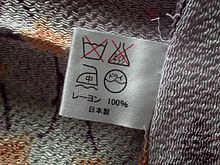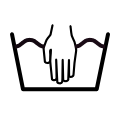- Laundry symbol
-
A laundry symbol, also called a care symbol, is a pictogram which represents a method of washing, for example drying, dry-cleaning and ironing clothing. Such symbols are written on labels, known as care labels, attached to clothing to indicate how a particular item should best be cleaned. There are different standards for care labels for the different countries/regions of the world. In some standards, pictograms coexist with or are complemented by written instructions.
Treatment indicated by the symbols is "the maximum permitted treatment" and is not required or recommended. GINETEX states that "milder forms of treatment and lower temperatures than those indicated on the label are always permitted." For example, if a symbol indicates washing in hot water and tumble drying, washing in cold water and drying on a clothes line are also acceptable.
The Canadian system was formerly the most colorful one, using three colours: green for "go ahead", yellow for "be careful", and red for "stop". This system has been abandoned with the decision to move to a common international scheme.[citation needed]
GINETEX, based in France, is the international association for textile care labelling, and formed in 1963 after academic conferences in the late 1950s were formed to define one standard of labelling.
Contents
General
The care label describes the allowable treatment of the garment without damaging the textile. Whether this treatment is necessary or sufficient, is not stated. A milder than specified treatment is always acceptable. The symbols are protected and their use is required to comply with the license conditions. Incorrect labelling is prohibited. A bar below each symbol calls for a gentler treatment than usual and a double bar for a very gentle treatment.
Washing
A stylized washtub is shown, and the number in the tub means the maximum wash temperature (degrees Celsius). A bar under the tub signifies a gentler treatment in the machine. A double bar signifies very gentle handling. A hand in the tub signifies that only (gentle) hand washing (not above 40°C) is allowed. A cross through washtub means that the textile may not be washed under normal household conditions.
Bleaching
An empty triangle (formerly lettered Cl) allows the bleaching with chlorine or oxygen. Two oblique lines in the triangle allow only oxygen as a bleaching agent. A crossed triangle prohibits any bleaching.
Drying
A circle in the square symbolizes a dryer. One dot requires drying at reduced temperature and two dots for normal temperature. The crossed symbol means that the clothing does not tolerate machine drying. In the U.S. and Japan, there are other icons for natural drying.
Tumble drying
Natural drying
Ironing
The iron with up to three dots allows for ironing. The number of dots are assigned temperatures: One point means 110°C, two points means 150°C and three points means 200°C. An iron with a cross prohibits ironing.
Professional Cleaning
Main article: SurfactantA circle identifies the possibilities of professional cleaning. A bar under the symbol means clean gently, and two bars means very gentle cleaning.
Chemical cleaning
The letters P and F in a circle are for the different solvents used in the professional dry cleaner can be used..
-
Dryclean, any solvent except PCE
Wet cleaning
The letter W in a circle is for professional wet cleaning.
See also
External links
- ISO 3758:2005 - Textiles care labelling code using symbols
- care-labelling.co.uk - Home Laundering Consultative Council - What Symbols Mean
- ic.gc.ca - The revised Canadian standard
- waschsymbole.de - Washing symbols according to the European standard
- butiksdatabasen.se - Swedish washing symbols
- textileaffairs.com - United States care symbols
- indiantextilejournal.com - Further care symbols, including Japanese
- CFAccessories.com - US, Japanese, and UK woven washing label symbols
- Laundry Guide to Common Care Symbols Textile Industry Affairs
- Guide to Common Home Laundering & Drycleaning Symbols Textile Industry Affairs
Clothing Materials Tops Blouse · Crop top · Dress shirt · Halterneck · Henley shirt · Hoodie · Jersey · Guernsey · Poet shirt · Polo shirt · Shirt · Sleeveless shirt · Sleeveless sweater · Sweater · T-shirt · Tube top · Turtleneck · TwinsetTrousers or pants Bell-bottoms · Bermuda shorts · Bondage pants · Capri pants · Cargo pants · Culottes · Cycling shorts · Dress pants · Jeans · Jodhpurs · Overall · Parachute pants · Phat pants · Shorts · Sweatpants · WindpantsSkirts A-line skirt · Ballerina skirt · Fustanella · Hobble skirt · Jean skirt · Job skirt · Leather skirt · Kilt · Men's skirts · Microskirt · Miniskirt · Pencil skirt · Poodle skirt · Prairie skirt · Rah-rah skirt · Sarong · Skort · Slip · Train · WrapDresses Ball gown · Cocktail dress · Débutante dress · Evening gown · Gown · Jumper dress · Little black dress · Petticoat · Sari · Sundress · Tea gown · Wedding dress · Wrap dressSuits and uniforms Academic dress · Afrocentric suit · Black tie · Buddhist monastic robe · Clerical clothing · Court dress · Gymslip · Jumpsuit · Lab coat · Lounge suit · Mao suit · Morning dress · Pantsuit · Red Sea rig · Scrubs · Stroller · Tangzhuang · Tuxedo · White tieOuterwear Abaya · Academic gown · Anorak · Apron · Blazer · Cagoule · Cloak · Coat · Duffle coat · Duster · Frock coat · Jacket · Greatcoat · Leather jacket · Goggle jacket · Hoodie · Opera coat · Overcoat · Pea coat · Poncho · Raincoat · Redingote · Robe · Shawl · Shrug · Ski suit · Sleeved blanket · Sports coat · Top coat · Trench coat · Vest · Waistcoat · WindbreakerUnderwear Boxer briefs · Boxer shorts · Brassiere · Briefs · Bustle · Compression sportswear · Corselet · Corset · Diaper · Dickey · Lingerie · Loincloth · Long underwear · Panties · Teddy · Temple garment · Trunks · Undershirt · IzaarAccessories Ascot tie · Belly chain · Belt · Bolo tie · Bow tie · Chaps · Coin purse · Cufflink · Earring · Gaiters · Gloves · Hairpin · Handbag · Leg warmer · Leggings · Muff (handwarmer) · Necklace · Necktie · Scarf · Shoe buckle · Stocking · Sunglasses · Suspenders · TightsFootwear Athletic shoe · Boot · Court shoe · Dress shoe · Flip-flops · Hosiery · Sandal · Shoe · Slipper · SockHeadwear Nightwear Swimwear Bikini · Boardshorts · One-piece · Square leg suit · Swim briefs · Swim cap · Swim diaper · Swim trunks · WetsuitClothing parts Back closure · Buckle · Bustline · Button · Buttonhole · Collar · Cuff · Elastic · Fly · Hemline · Hook-and-eye · Lapel · Neckline · Pocket · Revers · Shoulder pad · Shoulder strap · Sleeve · Snap · Strap · Velcro · Waistline · ZipperNational costume Albanian dress · Abaya · Aboyne dress · Áo bà ba · Áo dài · Áo tứ thân · Batik · Baro't saya & Barong Tagalog · Bunad · Þjóðbúningurinn · Cheongsam (Qípáo) · Dashiki · Deel · Dhoti · Dirndl · Djellaba · Gákti · Gho & Kira · Han Chinese clothing · Hanbok · Highland dress · Jellabiya · Jilbāb · Kebaya · Kente cloth · Kilt · Kimono · Lederhosen · Sampot · Sarafan · Sari · Sarong · Shalwar kameez · Sherwani · ThawbHistorical garments Banyan · Bedgown · Bodice · Braccae · Breeches · Breeching · Brunswick · Caraco · Chemise · Cravat · Chiton · Chlamys · Close-bodied gown · Doublet · Exomis · Farthingale · Frock · Himation · Hose · Houppelande · Jerkin · Justacorps · Knickerbockers · Palla · Peplos · Polonaise · Sack-back gown · Smock-frock · Stola · Toga · TunicHistory and surveys See also Adaptive clothing · Clothing terminology · Costume · Dress code · Fashion · Formal wear · Ironing · Laundry · Locking clothing · Maternity clothing · Reversible garmentCategories:- Laundry
- Pictograms
- Consumer symbols
Wikimedia Foundation. 2010.









































